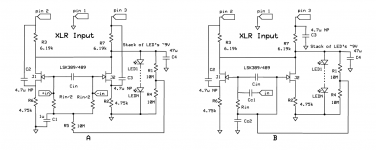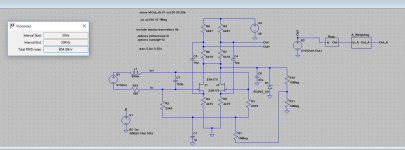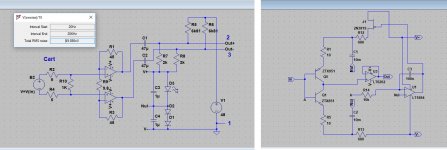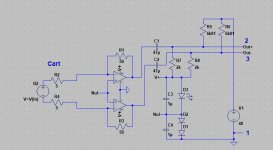Hi Bill,
The 0.01% for the Aurak was absolutely correct, because it uses a different topology, being current driven and not voltage driven, not at all having a CM gain of 0db like U8/U9 in posting#10.
A high CMRR can only be achieved in that case by carefully matching resistors.
Hans
The 0.01% for the Aurak was absolutely correct, because it uses a different topology, being current driven and not voltage driven, not at all having a CM gain of 0db like U8/U9 in posting#10.
A high CMRR can only be achieved in that case by carefully matching resistors.
Hans
Hans have you considered phantom power? Let's say for LP transfer using a popular external device like the Focusrite 2i2 which has phantom power for mics and decent low noise preamps. My results have been very encouraging with software RIAA. There are a lot of folks that want a simple solution to transfer LP's, and I like the idea of no batteries no external supply. etc.
I've been a little hesitant to promote this heavily because I actually think there is a nice cottage product in there somewhere.
Scott,
I have looked at the 2i2, but I can’t find the input impedances of both inputs, they are probably different, and I can’t find the amount of current that can be supplied.
With 6k81 resistors it will be only a few mA.
Do you have any additional info?
Hans
Standard phantom power setup 6K81 on each input for 0V left at 14mA, I have some nice diagrams in my Linear Audio article. In practice mics rarely draw more than 3 or 4mA but with cap coupling there are tricks to reuse the current. You need to take care to keep the draw balanced on each input.
The input impedance is in the service manual, typically it's fairly low from XLR and high on TRS in line-in mode. You need to be careful to note how the combo XLR/TRS is used. I've seen devices that don't let you use a stereo TRS as a low level differential mic input and apply phantom power.
The input impedance is in the service manual, typically it's fairly low from XLR and high on TRS in line-in mode. You need to be careful to note how the combo XLR/TRS is used. I've seen devices that don't let you use a stereo TRS as a low level differential mic input and apply phantom power.
Hans here's a couple of ideas for a simple buffer for MM/MI into a phantom powered mic input. Differential and single ended. You may want to increase that 47u cap and of course you can use zeners or IC shunt regulators.
Attachments
Last edited:
I've put the Balanced version in LTspice. Noise from 20Hz to 20Khz is 455nV after Riaa and A-Weighting, corresponding to 3.2nV/rtHz.Hans here's a couple of ideas for a simple buffer for MM/MI into a phantom powered mic input. Differential and single ended. You may want to increase that 47u cap and of course you can use zeners or IC shunt regulators.
So when you put the output in a Mic input of some 2i2 device with a high enough input impedance, you have your gear complete.
Hans
Attachments
That looks good, perfect (for MM/MI) in front of many of the field recorders too. I have one more version that might be of interest but it will take a couple of days to draw up. As drawn I think you could give each FET more current if you need to drive a little more load, but I think the levels are so low it does not matter.
The single ended version above is less interesting and you don't need the second FET. It was originally meant to be a jumper programmed SE/Diff circuit.
I have also built versions using the floating battery idea (9V) for completeness. It would be nice to put all the versions together in a library so everyone can choose what works best for them.
The single ended version above is less interesting and you don't need the second FET. It was originally meant to be a jumper programmed SE/Diff circuit.
I have also built versions using the floating battery idea (9V) for completeness. It would be nice to put all the versions together in a library so everyone can choose what works best for them.
Last edited:
Driven 300 miles this evening
And you stayed in the UK!
Last edited:
And you stayed in the UK!
Is that like Land's End to John O'Groats?
Scott, two parts that I suggest to be changed:
C1 of 1uF serves no function, but reduces CMRR.
This one could be replaced by a 47pF cap for HF suppression
C2 and C3 cause the output impedance to be very high at LF, 1k5@20Hz going to 65 Ohm@10Khz.
When changing into 47uF, this impedance drops to 165 Ohm@20Hz.
Hans.
C1 of 1uF serves no function, but reduces CMRR.
This one could be replaced by a 47pF cap for HF suppression
C2 and C3 cause the output impedance to be very high at LF, 1k5@20Hz going to 65 Ohm@10Khz.
When changing into 47uF, this impedance drops to 165 Ohm@20Hz.
Hans.
Last edited:
Is that like Land's End to John O'Groats?
That's 874miles, which is only slightly more than I've managed on a US road trip. Mainly because if you head west from Boston there's an awful lot of trees and not much else!
Here's a HeadAmp with Phantom Power, in this case displayed with a gain of 20dB. The OpAmp in the left image is shown in detail on the right. Equivalent A-weighted input noise of this HeadAmp is 50nv including the 10 Ohm Cart. With a Gain of 20dB this translates into 500nV at the output. The 2i2 produces 316nV eq a-weighted input noise, so both add up to 590nV or 59nV RTI, resulting in 78.5 dBA S/N. Gain can be changed without any problem from 20dB to 26dB in case of using a Cart with a lower output.
Power supply comes from 2 Diodes and one LED, giving resp 1,2 Volt and 4 Volt. Current through the ZTX851/ZTX951 is adjusted to 1 mA with R12/R13.
Hans
Power supply comes from 2 Diodes and one LED, giving resp 1,2 Volt and 4 Volt. Current through the ZTX851/ZTX951 is adjusted to 1 mA with R12/R13.
Hans
Attachments
Being dense as ever, it's just clicked that the MM buffer is what Holman was using back in the 70s for his most famous article. In that case to show the limitations (in his view) of phono stages of the day. Would be fascinating to take a 9v powered version of this and see if you could persuade people to try it in front of their favourite flawed phono stage.
Of course as it could actually improve matters it would be frowned upon
Of course as it could actually improve matters it would be frowned upon
And here is the correct voltage input version. There was nothing really wrong, just a matter of confusingly using the label 'Nul' on different positions, which I have changed immediately. And since for a certain current an NPN has a better defined Vbe than a Fet for Vgs, I have replaced the 2N3818 for a 2N3904, but both are possible as long as the steering output of the LT1884 stays at least 0.5 Volt within its power supply voltages. Last but not least, I had forgotten to connect the Cart to Nul.
Hans
Hans
Attachments
- Status
- This old topic is closed. If you want to reopen this topic, contact a moderator using the "Report Post" button.
- Home
- Source & Line
- Analogue Source
- Designing a universal diff-in/diff-out Head Amp




